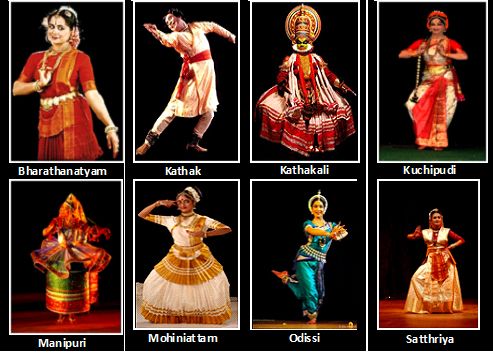Focus: GS 1 ; Indian culture will cover the salient aspects of Art Forms, literature and Architecture from ancient to modern times.
Why in News?
After the overwhelming response to the first part of Nrityanjali, an online festival of documentary films on the life and work of some of the leading Indian classical dance exponents, Films Division is presenting the concluding part of the festival where well-researched documentaries on the distinct styles, depth and nuances of some of the ancient and popular classical dances.
About Classical Dances of India;-
India is known for its rich cultural heritage. Diversification is the identity of the country. Indian dance is one of the most revered identities of our culture.
In India, dance forms can be broadly classified into 2 categories- Classical and Folk Dance form.
These dance forms have been originated from different parts of India as per the local tradition.
The classical dance form originated from the Natya Shastra, there are 8 classical dance forms in India as per the source and scholar.
The Natya Shastra is termed as 5th Veda i.e. Brahma Deva withdrew himself into an intense concentration of mind, recalled the four Vedas and created the fifth Veda called Natya Veda.
He took the lyrics from the Rigveda, music from Samaveda, the language of gestures and emotions from the Yajurveda and the aesthetic experience or Rasa from Atharvaveda.


The Cultural Ministry of India has included Chhau into the list of classical dances that makes a total of 9 classical dance form.
Excavations, inscriptions, chronicles, genealogies of kings and artists, literary sources, sculpture and painting of different periods provide extensive evidence on dance in India.
Contemporary classical dance forms have evolved out of the musical play or sangeet-nataka performed from the 12th century to the 19th century.
The Indian classical dances have two basic aspects – Tandava (movement & rhythm) and Lasya (grace, bhava & rasa).
The three main components are;-
Natya (the dramatic element of the dance i.e. the imitation of characters)
Nritta (the dance movements in their basic form)
Nritya (expressional component i.e. mudras or gestures).
The nine rasas are – Love, Heroism, Pathos, Humor, Anger, Fear, Disgust, Wonder and Peace.
The Natya Shastra written by Bharat Muni is the most prominent source for the Indian aestheticians for establishing the characteristics of the dances.
The 9 basic technicalities that are expressed in the classical dance are given below:-
Shringar: Love
Hasya: Humorous
Karuna: Sorrow
Raudra: Anger
Veer: Heroism
Bhayanak: Fear
Bibhats: Disgust
Adbhoot: Wonder
Shanta : Peaceful

CLASSICAL DANCE;-
The term “classical” was introduced by Sangeet Natak Akademi to denote the Natya Shastra-based performing art styles. These are described as below:-





